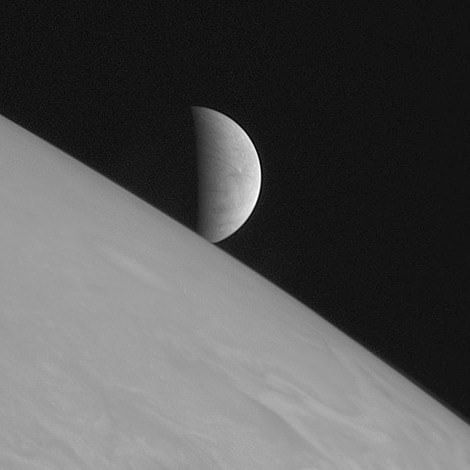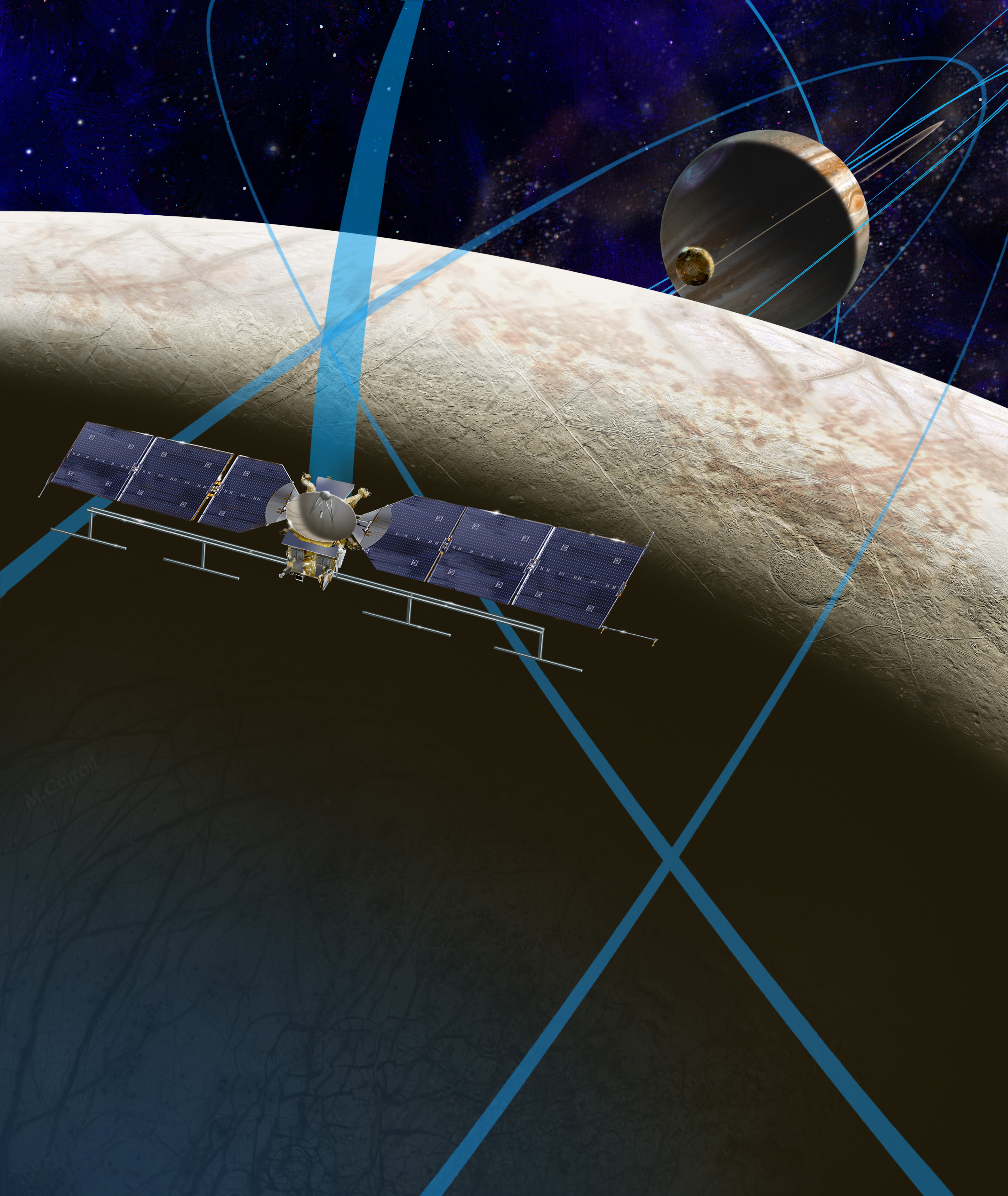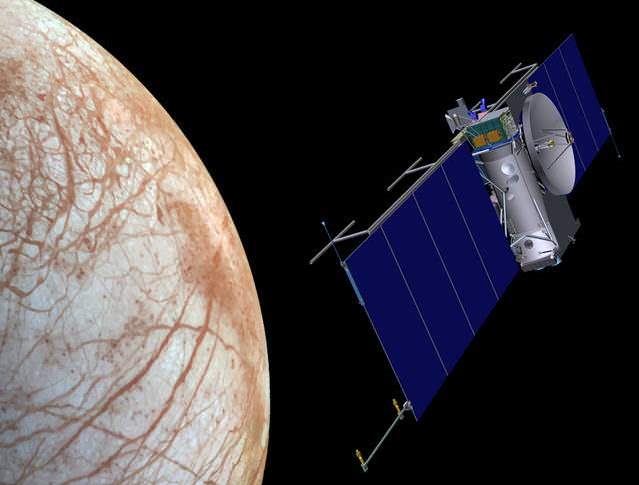Artist’s concept of NASA mission streaking over ocean world of Europa. Credit: NASA/JPL
Story updated[/caption]
At long last NASA is heading back to Jupiter’s mysterious moon Europa and doing so in a big way – because scientists believe it harbors an alien ocean of water beneath an icy crust and therefore is “one of the most promising places in the solar system to search for signs of present-day life” beyond Earth.
Top NASA officials have now formally and officially green lighted the Europa ocean world robotic mission and given it the “GO” to move from early conceptual studies into development of the interplanetary spacecraft and mission hardware, to search for the chemical constituents of life.
“Today we’re taking an exciting step from concept to mission, in our quest to find signs of life beyond Earth,” said John Grunsfeld, associate administrator for NASA’s Science Mission Directorate in Washington, in a NASA statement.
The goal is to investigate the habitability of Europa’s subsurface ocean, determine if it possesses the ingredients for life and advance our understanding of “Are we Alone?”
“Observations of Europa have provided us with tantalizing clues over the last two decades, and the time has come to seek answers to one of humanity’s most profound questions,” said Grunsfeld.
Water is a prerequisite for life as we know it.
“We know that on Earth everywhere there is water we find life,” says Robert Pappalardo, Europa mission project scientist.
“Therefore Europa is the most likely place to find life in our solar system today because we think there is a liquid water ocean beneath its surface.”
Video caption: Alien Ocean: NASA’s Mission to Europa. Could a liquid water ocean beneath the surface of Jupiter’s moon Europa have the ingredients to support life? Here’s how NASA’s mission to Europa would find out. Credit: NASA
After a thorough review of the mission concept, managers agreed that it “successfully completed its first major review by the agency and now is entering the development phase known as formulation
“It’s a great day for science,” said Joan Salute, Europa program executive at NASA Headquarters in Washington.
“We are thrilled to pass the first major milestone in the lifecycle of a mission that will ultimately inform us on the habitability of Europa.”
In a major milestone leading up to this mission development approval, NASA managers recently announced the selection of the nine science instruments that will fly on the agency’s long awaited planetary science mission to this intriguing world that many scientists suspect could support life, as I reported here last month.
“We are trying to answer big questions. Are we alone,” said Grunsfeld at the May 26 media briefing.
“The young surface seems to be in contact with an undersea ocean.”

Planetary scientists have long desired a speedy to return on Europa, ever since the groundbreaking discoveries of NASA’s Galileo Jupiter orbiter in the 1990s showed that the alien world possessed a substantial and deep subsurface ocean beneath an icy shell that appears to interact with and alter the moon’s surface in recent times.
NASA’s Europa mission would blastoff perhaps as soon as 2022, depending on the budget allocation and rocket selection – whose candidates include the heavy lift Space Launch System (SLS) now under development to launch astronauts on deep space expedition to the Moon, Asteroids and Mars.
The solar powered Europa probe will go into orbit around Jupiter for a three year mission in order to minimize exposure to the intense radiation region that could harm the spacecraft.
The Europa mission goal is to investigate whether the tantalizing icy Jovian moon, similar in size to Earth’s moon, could harbor conditions suitable for the evolution and sustainability of life in the suspected ocean.
It will be equipped with high resolution cameras, spectrometers and radar, several generations beyond anything before to map the surface in unprecedented detail and determine the moon’s composition and subsurface character. And it will search for subsurface lakes and seek to sample erupting vapor plumes like those occurring today on Saturn’s tiny moon Enceladus.
There will many opportunities for close flybys of Europa during the three year primary mission to conduct unprecedented studies of the composition and structure of the surface, icy shell and oceanic interior.
“During the three year mission, the orbiter will conduct 45 close flyby’s of Europa,” Curt Niebur, Europa program scientist at NASA Headquarters in Washington, told Universe Today.
“These will occur about every two to three weeks.”
The close flyby’s will vary in altitude from 16 miles to 1,700 miles (25 kilometers to 2,700 kilometers).

The mission currently has a budget of about $10 million for 2015 and $30 Million in 2016. Over the next three years the mission concept will be further defined.
The mission will be managed by NASA’s Jet Propulsion Laboratory (JPL) in Pasadena, California and is expected to cost in the range of at least $2 Billion or more.
The nine science instruments are described in my earlier story- here. They will be developed and built by Johns Hopkins University Applied Physics Laboratory (APL); JPL; Arizona State University, Tempe; the University of Texas at Austin; Southwest Research Institute, San Antonio and the University of Colorado, Boulder.

Right now there is another NASA probe bound for Jupiter, the solar powered Juno orbiter that will investigate the origin of the gas giant. But Juno will not be conducting any observations or flyby’s of Europa.
Stay tuned here for Ken’s continuing Earth and planetary science and human spaceflight news.
………….
Learn more about SpaceX, Europa, Mars rovers, Orion, SLS, Antares, NASA missions and more at Ken’s upcoming outreach events:
Jun 25-27: “SpaceX launch, Orion, Commercial crew, Curiosity explores Mars, MMS, Antares and more,” Kennedy Space Center Quality Inn, Titusville, FL, evenings


WHO will be the first to walk on Europa? It will eventually happen you know…
The first robot you mean !Because on the surface of Europa there is too much radiation from Jupiter’s belts.The radiations in Jupiter’s belts are a million times more intense than in Earth’s belts !
Perhaps these mission scientist ought to read Arthur Clarke’s 2061: Odyssey Three before spending any more money. 😉
Well guess flybys are still better than dreaming about a robosub in that ocean. And hopefully there will be spectral analyzers on-board – we don’t wanna wait for lower swoops to figure out maybe a bright spot of euroseal poop
Still lobbying for my suggested name: SearCH for Life on Europa Probe or SCHLEP
LMAO!!
Great! Europa is the best candidate yet for life beyond Earth at last we are getting somewhere to prove once and for all that life is quite common in the Cosmos……
I think the statement made in the NASA video (that should life on Europa exist it would have almost certainly originated independently of Earth’s life ) is uncharacteristically speculative, as is the perception that discovery of life there will constitute a definitive answer to the big question.
I agree with bjmorris that it is extremely speculative to assume any found life form in the solar system to be truly earth independent. Anyway, when are we actually going make a probe which looks for extra-terrestrial life itself? Are such tests / equipment beyond our technical capabilities?
I read this headline, screamed with joy and teared-up the whole read through the article! I’m almost 50 and seeing us find ANYTHING that wiggles off-world has been my life’s goal…. THIS is AMAZING news!!! I hope the residue around the fissures is FULL of life-caused organics!… Just ONE niggle-point: Per the line, “Water is a prerequisite for life as we know it”, it’s not JUST water, it’s ANY solvent. As long as something is there to allow other compounds to dissolve and recombine, it’s golden, though obviously in this case it IS H2O.
Well said 100%
Water has some nice properties that other solvents don’t.
Firstly, it has a very high surface tension. This property makes capillary action possible, which is of course very useful to living things because it can transport nutrients around.
Secondly, ice has a lower density than liquid water. It naturally forms a protective, insulating layer on top of the liquid. Oceans made from other solvents would freeze from the bottom up, and freeze all the way through. With water, you get a shell that keeps the ocean liquid, and shields against radiation.
Other solvents could potentially support life, but water is so much better at it than all the other alternatives that it’s hard to imagine life not “picking” water as its medium of choice whenever possible.
Sorry, Jeffrey. The aliens left the message:
“- Don’t look for us, we’ll call you.”
We can’t even define life. We think it’s like we are and hope we’ll recognize it when we see it. And we look for it (us?) inside of a big piece of ice out there.
Hey Ken, Your link to the 9 instruments included story isn’t active, BTW.
“The nine science instruments are described in my earlier story- **here**”
fixed along with some other additions